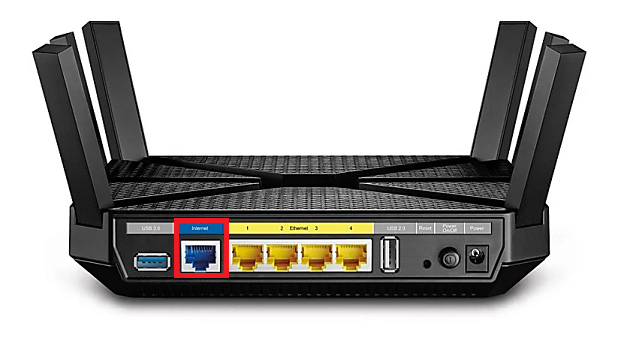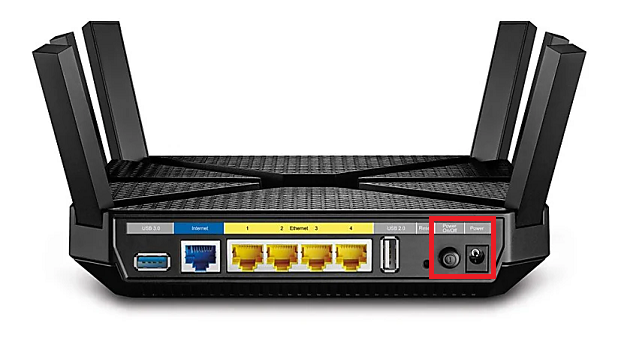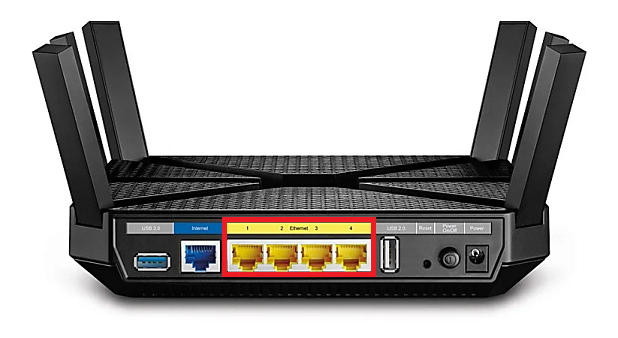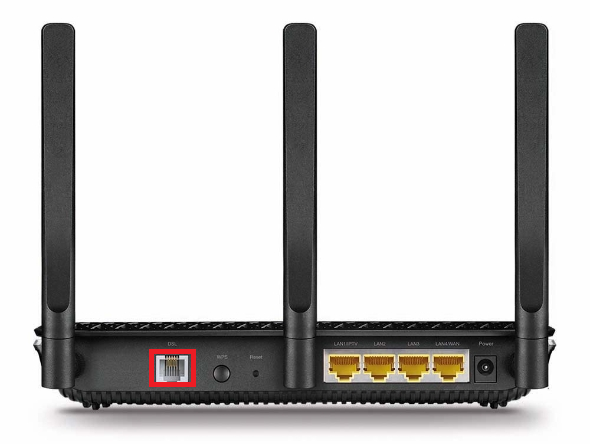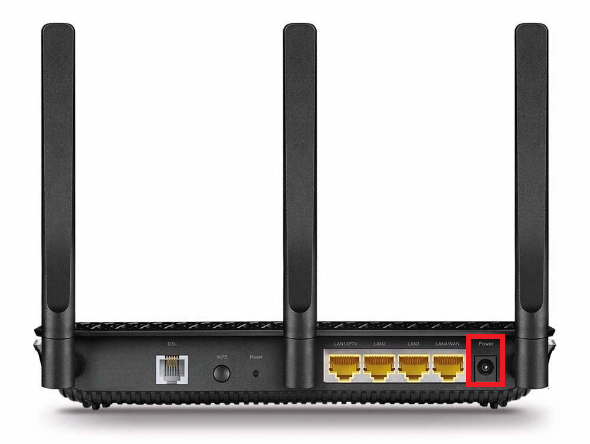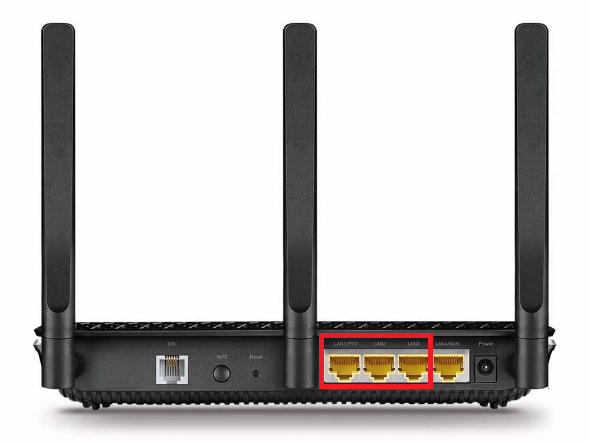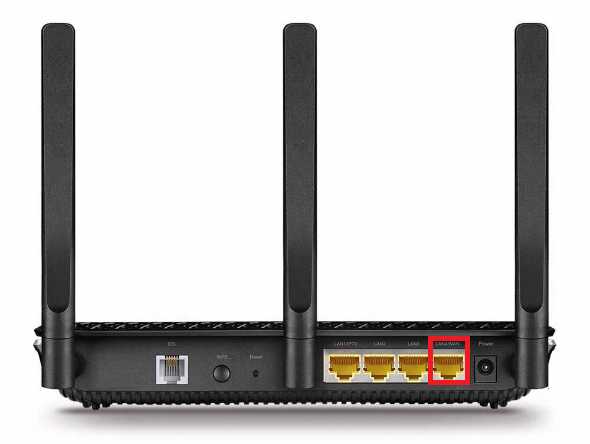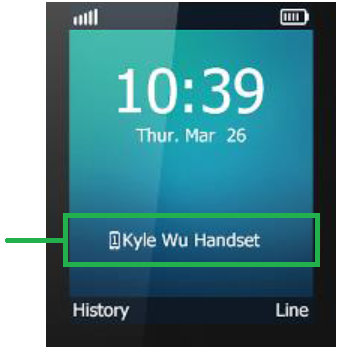You'll need to plug in your modem and change some settings to get it working with TPG nbn FTTP.
-
First, make sure you’ve got a message from us asking you to plug in your nbn modem. We need to get your connection ready on our side before you plug in.
-
Find your nbn Connection Box (NCB) – this is usually installed on the inside of an exterior wall in your home, sometimes in the garage. Unplug any old modem from the nbn Connection Box and power outlet.
-
Use the Ethernet cable to connect your modem's blue Internet port to your NCB's UNI-D1 port.
The message from us will tell you if you need to use a different UNI-D port. -
Use the power cable to connect your modem's Power port to a power outlet. Press your modem's Power button to turn it on.
- To connect devices to the WiFi, you'll find the default WiFi name and password on your modem's barcode sticker.
- If you have extra Ethernet cables, you can connect up to 4 devices to your modem’s Ethernet ports.
-
Open your web browser and go to: https://192.168.0.1
-
Log in with the default username "admin" and default password "admin" on your modem's barcode sticker. If you have custom login details, use those instead.
-
Select Advanced > Network > Internet.
-
Set Internet Connection Type to PPPoE.
-
Enter your TPG username and password.
Your TPG username can be found in emails from us about your TPG order. If you've forgotten your password, reset your password. -
Hit Save and you're good to go.
Can't get online? Call us on 1300 997 271 and we'll help you.
Please select your handset to view the troubleshooting guide:
If your handset is not listed here, please contact us for assistance.
You'll need to plug in your modem and change some settings to get it working with TPG nbn FTTB/N.
- First, make sure you’ve got a message from us asking you to plug in your nbn modem. We need to get your connection ready on our side before you plug in.
- Find your phone wall socket – you probably already have a modem plugged in from your last internet service. Unplug any old modem from the phone wall socket and power outlet.
- Use the phone cable to connect your modem’s grey DSL port to your phone wall socket.
-
Use the power cable to connect your modem's Power port to a power outlet. Press the Power button on the side of your modem to turn it on.
- To connect devices to the WiFi, you'll find the default WiFi name and password on your modem's barcode sticker.
- If you have extra Ethernet cables, you can connect up to 4 devices to your modem’s yellow LAN ports.
-
Open your web browser and go to: https://192.168.0.1 or https://tplinkmodem.net
-
Log in with the default username "admin" and the default password "admin" on your modem's barcode sticker. If you have custom login details, use those instead.
-
Select Basic > Internet.
-
For ISP, choose Other.
-
Set Modulation to VDSL.
-
If you have a bundled nbn & phone plan: Tick the box for VLAN ID and enter 2.
-
Set Internet Connection Type to PPPoE.
-
Enter your TPG username and password.
Your TPG username can be found in emails from us about your TPG order. If you've forgotten your password, reset your password. -
Hit Save and you're good to go.
Can't get online? Call us on 1300 997 271 and we'll help you.
You'll need to plug in your modem and change some settings to get it working with TPG nbn FTTC.
- First, make sure you’ve got a message from us asking you to plug in your nbn modem. We need to get your connection ready on our side before you plug in.
- Find your phone wall socket and nbn Connection Device (NCD) – you probably already have a modem plugged in from your last internet service. Unplug any old modem from the NCD and power outlet.
If your NCD is missing, please call us on 1300 023 575. -
Use the Ethernet cable to connect your modem’s yellow LAN/WAN port to your NCD's yellow Gateway port.
-
Use the power cable to connect the Power port on your modem to a power outlet. Press the Power button on the side of your modem to turn it on.
- To connect devices to the WiFi, you'll find the default WiFi name and password on your modem's barcode sticker.
- If you have extra Ethernet cables, you can connect up to 3 devices to your modem’s yellow LAN ports.
-
Open your web browser and go to: https://192.168.0.1 or https://tplinkmodem.net
-
Log in with the default username "admin" and the default password "admin" on your modem's barcode sticker. If you have custom login details, use those instead.
-
Select Advanced > Operation Mode > Wireless Router Mode.
-
Select Wireless Router Mode and hit Save. Wait for your modem to reboot.
-
Select Basic > Internet.
-
For ISP, choose Other.
-
If you have a bundled nbn & phone plan: Tick the Enable box for VLAN ID and enter 2.
-
Set Internet Connection Type to PPPoE.
-
Enter your TPG username and password.
Your TPG username can be found in emails from us about your TPG order. If you've forgotten your password, reset your password. -
Hit Save and you're good to go.
Can't get online? Call us on 1300 997 271 and we'll help you.
You'll need to plug in your modem and change some settings to get it working with TPG nbn HFC.
-
First, make sure you’ve got a message from us asking you to plug in your nbn modem. We need to get your connection ready on our side before you plug in.
-
Find your phone wall socket and nbn Connection Device (NCD) – you probably already have a modem plugged in from your last internet service. Unplug any old modem from the NCD and power outlet.
If your NCD is missing, please call us on 1300 023 575. -
Use the Ethernet cable to connect your modem’s yellow LAN/WAN port to your NCD's UNI-D1 port or 2.5G port.
-
Use the power cable to connect your modem's Power port to a power outlet. Press the Power button on the side of your modem to turn it on.
- To connect devices to the WiFi, you'll find the default WiFi name and password on your modem's barcode sticker.
- If you have extra Ethernet cables, you can connect up to 3 devices to your modem’s yellow LAN ports.
-
Open your web browser and go to: https://192.168.0.1 or https://tplinkmodem.net
-
Log in with the default username "admin" and the default password "admin" on your modem's barcode sticker. If you have custom login details, use those instead.
-
Select Advanced > Operation Mode.
-
Hit Wireless Router Mode.
-
Hit Save and wait for your modem to reboot.
-
Select Basic > Internet.
-
For ISP, choose Other.
-
If you have a bundled nbn & phone plan: Tick the Enable box for VLAN ID and enter 2.
-
Set Internet Connection Type to PPPoE.
-
Enter your TPG username and password.
Your TPG username can be found in emails from us about your TPG order. If you've forgotten your password, reset your password. -
Hit Save and you're good to go.
Can't get online? Call us on 1300 997 271 and we'll help you.
You'll need to plug in your modem and change some settings to get it working with TPG nbn FTTP.
-
First, make sure you’ve got a message from us asking you to plug in your nbn modem. We need to get your connection ready on our side before you plug in.
-
Find your nbn Connection Box (NCB) – this is usually installed on the inside of an exterior wall in your home, sometimes in the garage. Unplug any old modem from the nbn Connection Box and power outlet.
-
Use the Ethernet cable to connect your modem's yellow LAN/WAN port to your NCB's UNI-D1 port.
The message from us will tell you if you need to use a different UNI-D port. -
Use the power cable to connect your modem's Power port to a power outlet. Press the Power button on the side of your modem to turn it on.
- To connect devices to the WiFi, you'll find the default WiFi name and password on your modem's barcode sticker.
- If you have extra Ethernet cables, you can connect up to 4 devices to your modem’s Ethernet ports.
-
Open your web browser and go to: https://192.168.0.1 or https://tplinkmodem.net
-
Log in with the default username "admin" and default password "admin" on your modem's barcode sticker. If you have custom login details, use those instead.
-
Select Advanced, then Operation Mode.
-
Hit Wireless Router Mode.
-
Hit Save, then wait for your modem to reboot.
-
Select Basic, then Internet.
-
For ISP, choose Other.
-
Set Internet Connection Type to PPPoE.
-
Enter your TPG username and password.
Your TPG username can be found in emails from us about your TPG order. If you've forgotten your password, reset your password. -
Hit Save and you're good to go.
Can't get online? Call us on 1300 997 271 and we'll help you.
How to check registration
To confirm the handset is registered, check that your handset shows a name in the bottom half of the screen:
Note: If your handset is registered but cannot receive calls, it may be DND (Do Not Disturb) mode. To turn this off, press the OK button to enter the main menu. Select Call Features > Do Not Disturb, use the left and right arrow keys to toggle between "Enable" and "Disable, then Save. Calls should connect to the handset again.
Troubleshooting Network Unavailable or Handset not registering
-
Confirm that you can access the internet on a device that's connected to the same internet connection as your BizPhone handset.
-
Make sure your handset is successfully registered by checking the screen (see advice above).
-
Check your handset is getting an IP address by pressing the OK button, selecting the Status tab in the top left corner and pressing OK. The handset should display an IPv4 address.
-
Restart your modem.
-
Restart your handset by disconnecting the power and Ethernet cables for 10 seconds, then reconnect.
-
If your handset fails to register, try connecting the cordless base station directly to your modem using an alternate Ethernet cable or LAN port.
-
Is your network set up to deliver static IP addresses to connected devices? BizPhone hardware must be assigned an IP address via DHCP.
-
To confirm your network allows access to the required server, Windows users should run an NSLookup test.
-
Factory reset your handset by pressing the OK button, then select Settings > System settings > Base reset and enter the PIN "0000". When the handset resets, it will automatically download the configuration from the BPX server.
-
Run the BizPhone connection test and make a note of the test result number from both the Speed and VoIP tests.
-
If you’re still unable to make or receive calls, please email bizphonesupport@tpg.com.au with your test result numbers and reference this troubleshooting article.
How to check registration
Check the handset screen for the following icons:
| Icon | Description | Notes |
|---|---|---|
| Network unavailable | The handset is not connecting to a network. Confirm your internet connection is online and cables are connected correctly. | |
| Registered successfully | The handset is connected to a network and the BizPhone server. You should be able to make and receive calls. | |
| Register failed | The handset is connected to a network but cannot register with our server. Calls cannot be made or received in this state. | |
| Registering | The handset is attempting to register to the BizPhone server. Calls cannot be made or received in this state. |
Note: If your handset is registered but cannot receive calls, check the DND (Do Not Disturb) status on your handset screen. Press the DND soft key on your handset to turn this off. Calls should connect to the handset again.
Troubleshooting Network Unavailable or Handset not registering
-
Confirm that you can access the internet on a device that's connected to the same internet connection as your BizPhone handset.
-
Make sure your handset is connected correctly to your modem or network switch.
-
Restart your handset by disconnecting the Ethernet and power cable from the back, then reconnect.
-
Check your handset is getting an IP address by pressing the OK button once. The handset should display connection options, including an IPv4 address.
-
Restart your modem.
-
If no IP address is given after the modem restart, try using an alternate Ethernet cable between your handset and modem.
-
Connect your handset directly to the modem, bypassing any internal office cabling you may have been using.
-
Connect your handset to an alternate LAN port on the back of your modem or network switch.
-
Factory reset your handset by holding the OK button for 10 seconds. While the handset is resetting, keep your eye on the screen to ensure it is trying to connect to the correct server.
-
If your handset still doesn't show an IP address, Windows users should run an NSLookup test.
-
Unplug your handset from the modem's LAN port and plug a computer into the same LAN port. Check if the computer can get online.
-
Is your network set up to deliver static IP addresses to connected devices? BizPhone hardware must be assigned an IP address via DHCP.
-
Run the BizPhone connection test and make a note of the test result number from both the Speed and VoIP tests.
-
If you’re still unable to make or receive calls, please email bizphonesupport@tpg.com.au with your test result numbers and reference this troubleshooting article.
This test is available for Windows users only. If you are unable to complete this test, please call us on 1300 365 313 (option 3) for assistance.
-
Click Start, then type "cmd" in the search bar.
-
Open the Command Prompt program.
-
In Command Prompt, type "nslookup dms.bizphone.tpgtelecom.com.au" then press Enter on your keyboard.
-
Make note of the IP Address in the nslookup results.
-
Staying in Command Prompt, type "ping" followed by the IP Address, then press Enter on your keyboard.
-
If the ping test is successful (example below) then devices on your network can connect to the required server.
-
If your ping test fails (example below) this means there is an issue with routing traffic to the address from your network.
The following ports must be open to allow traffic flow to the server address:
Destination IP Address Protocol Port Number(s) 203.63.96.24 TCP 80, 443 203.63.96.25 TCP 80, 443 203.63.96.26 TCP 80, 443 203.63.96.27 TCP 80, 443 203.63.96.28 TCP 80, 443 203.185.248.15 TCP/UDP 5060 202.92.115.50 TCP/UDP 5060 203.185.248.15 UDP 60000 - 65535 202.92.115.50 UDP 60000 - 65535 203.63.96.15 UDP 123
How to check registration
Check the handset screen for the following icons:
| Icon | Description | Notes |
|---|---|---|
| Network unavailable | The handset is not connecting to a network. Confirm your internet connection is online and cables are connected correctly. | |
| Registered successfully | The handset is connected to a network and the BizPhone server. You should be able to make and receive calls. | |
| Register failed | The handset is connected to a network but cannot register with our server. Calls cannot be made or received in this state. | |
| Registering | The handset is attempting to register to the BizPhone server. Calls cannot be made or received in this state. |
Note: If your handset is registered but cannot receive calls, check the DND (Do Not Disturb) status on your handset screen. Press the DND soft key on your handset to turn this off. Calls should connect to the handset again.
Troubleshooting Network Unavailable or Handset not registering
-
Confirm that you can access the internet on a device that's connected to the same internet connection as your BizPhone handset.
-
Make sure your handset is connected correctly to your modem or network switch.
-
Restart your handset by disconnecting the Ethernet and power cable from the back, then reconnect.
-
Check your handset is getting an IP address by pressing the OK button once. The handset should display connection options, including an IPv4 address.
-
Restart your modem.
-
If no IP address is given after the modem restart, try using an alternate Ethernet cable between your handset and modem.
-
Connect your handset directly to the modem, bypassing any internal office cabling you may have been using.
-
Connect your handset to an alternate LAN port on the back of your modem or network switch.
-
Factory reset your handset by holding the OK button for 10 seconds. While the handset is resetting, keep your eye on the screen to ensure it is trying to connect to the correct server.
-
If your handset still doesn't show an IP address, Windows users should run an NSLookup test.
-
Unplug your handset from the modem's LAN port and plug a computer into the same LAN port. Check if the computer can get online.
-
Is your network set up to deliver static IP addresses to connected devices? BizPhone hardware must be assigned an IP address via DHCP.
-
Run the BizPhone connection test and make a note of the test result number from both the Speed and VoIP tests.
-
If you’re still unable to make or receive calls, please email bizphonesupport@tpg.com.au with your test result numbers and reference this troubleshooting article.
